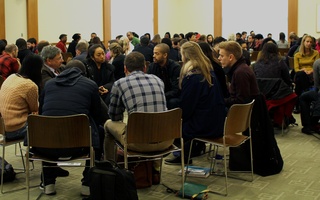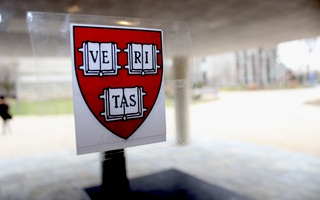UPDATED: March 9, 2016, at 11:50 a.m.
A months-long debate over Harvard Law School's controversial seal came to an uncertain close Friday, when a committee recommend the University replace it. But in the wake of the committee's lofty suggestion to retire the seal, alumni and affiliates responded with range of opinions on Royall family's crest, which the school has used for roughly 80 years and, for some, echoes of slavery.
While Law School affiliates agree that the committee’s recommendation to change the school’s seal was the expected result of a fair process, they remain divided over the recommendation itself.
A committee comprised of students, faculty, staff, and alumni released a recommendation Friday to change the school’s controversial seal, which has displayed the crest of the formerly slave-owning Royall family since its adoption in 1937. {shortcode-f67ca01642dd14fc5ace6f70f1978657eafa233a}
Law School Dean Martha L. Minow created the committee in mid-November in response to calls for the seal's removal by student activist group Royall Must Fall, whose members argued the seal’s association with slavery contributed to an inhospitable environment for minority students at the school. Friday’s recommendation, as well as a dissenting opinion from two committee members, was sent to members of the Harvard Corporation, who will make a final decision on the matter.
Now that the committee’s work has concluded, many Law School affiliates said the process was respectful and engaged a range of perspectives.
“I have found from the responses that I’ve received that many people...respect the care and respect with which the committee conducted itself, and often compliment us on having handled a difficult task in a fair and open and reasoned fashion,” committee chair and Law School professor Bruce H. Mann said.
Not all of the feedback Mann has received has been supportive of the change. He said he has received responses on both sides of the issue and called disagreement "inevitable."
"Whichever way we recommended, it was a certainty we would disappoint some people," Mann said. "Which was why we worked very hard to make sure that the process was as open and transparent and inclusive as possible."
For activists, the committee’s recommendation was an unsurprising victory. “It was exactly what I expected all along,” President of the Black Law Students Association Leland S. Shelton said. “After talking to some alumni and members of the Corporation, I had the feeling that the people who were defending the seal were few and far between. So I assumed that the committee would do their due diligence and write a thoughtful report about moving forward with a new shield.”
However, activists said they were disappointed the letter from Minow accompanying the report did not mention their efforts. “It totally elides over all of the tireless hard work that student activists, staff members, faculty members from across the University have been putting in day in and day out to make this happen,” Aparna Gokhale, a member of the group Reclaim Harvard Law, said.
Since Friday, Law School affiliates and the wider world have taken to social media to support or denounce the decision. Minow sent a letter to alumni on Friday with links to the report and dissent, as well as her endorsement of the committee’s recommendation.
Morgan Chu–a major donor to the Law School who graduated in 1976 and who previously served on Harvard’s Board of Overseers, the University's second-highest governing body–praised both the committee process and the recommendation itself. He said he would have voted in favor of discarding the seal, and hopes the Corporation will do so.
“I don’t think in the balance of all the variables that might be considered that the reasons to keep it were as strong as the reasons to retire it,” Chu said.
Sharon E. Jones ’77, a former president of the Harvard Law School Association who graduated in 1982, was one of the many alumni who weighed in on the issue during the committee’s deliberation process. “I felt the Law School did the right thing,” she said. “They could put it in a museum, and that way you preserve whatever history you want to say it represents. I think that it stands for things that the Law School no longer wants to stand for.”
Bertram H. Fields—a major donor who graduated in 1952—said he does not have strong leanings one way or another. He distinguished between the sheaves of wheat on the Royall crest and symbols like the Confederate flag. “I’m not that moved by the argument since it’s not a blatant symbol of slavery,” he said.
Marcia L. Narine, who graduated from the Law School in 1992, was part of a group of student activists who did not collect their diplomas at commencement in order to protest a lack of minority faculty at the school. As a former activist during a turbulent time in the Law School’s history, Narine said she did not view the shield itself as a pressing concern, but she was impressed with the attention administrators awarded it, a response she said she felt was markedly different from that of administrators when she was a student.
While students with dissenting opinions also commended administrators’ open approach, third-year Law student William H. Barlow, who has publicly decried activism at the school, said activists have created an environment that silences opposing voices.
“There’s tremendous amounts of social pressure, especially in a university that leans heavily left, to not say anything that could be perceived as offensive or hurtful. A lot of people have chosen to stay out of the debate because they don’t want to be called a racist,” Barlow said. “I know there are a lot of people who feel very constrained about how they can speak on campus, and they see this as a victory for a cause that they feel is silencing them.”
Activists emphasized that no matter what the Corporation decides, the end of the Royall crest as the school’s symbol will not mark an end to their activism.
Royall Professor of Law and committee member Janet Halley said many related issues were raised during the committee’s discussions, but the body’s work was limited in scope to the question of the seal.
“By no means did our charge close the chapter on Isaac Royall and racial inclusion at the Law School,” Halley said. “Those discussions need to continue.”
—Staff writer Claire E. Parker can be reached at claireparkerdc@gmail.com. Follow her on Twitter @ClaireParkerDC.
This article has been revised to reflect the following correction:
CORRECTION: March 9, 2016
A previous version of this story indicated that Morgan Chu currently serves on Harvard's Board of Overseers. In fact, Chu completed his term last year and no longer serves on the Board.
Read more in University News
Former Harvard Employee Pleads Guilty to Larceny, ForgeryRecommended Articles
-
 Committee and Activists Debate Law School Seal
Committee and Activists Debate Law School Seal -
 Law School Committee Prepares to Release Report on Seal
Law School Committee Prepares to Release Report on Seal -
Process MattersThe careful process undertaken by the Law School is a stark contrast to the one through which House Masters became Faculty Deans last month.
-
 After Corporation Approval, Law School Seal Quickly Disappearing
After Corporation Approval, Law School Seal Quickly Disappearing -
 Royall Descendant Cautions Against Forgetting History
Royall Descendant Cautions Against Forgetting History













